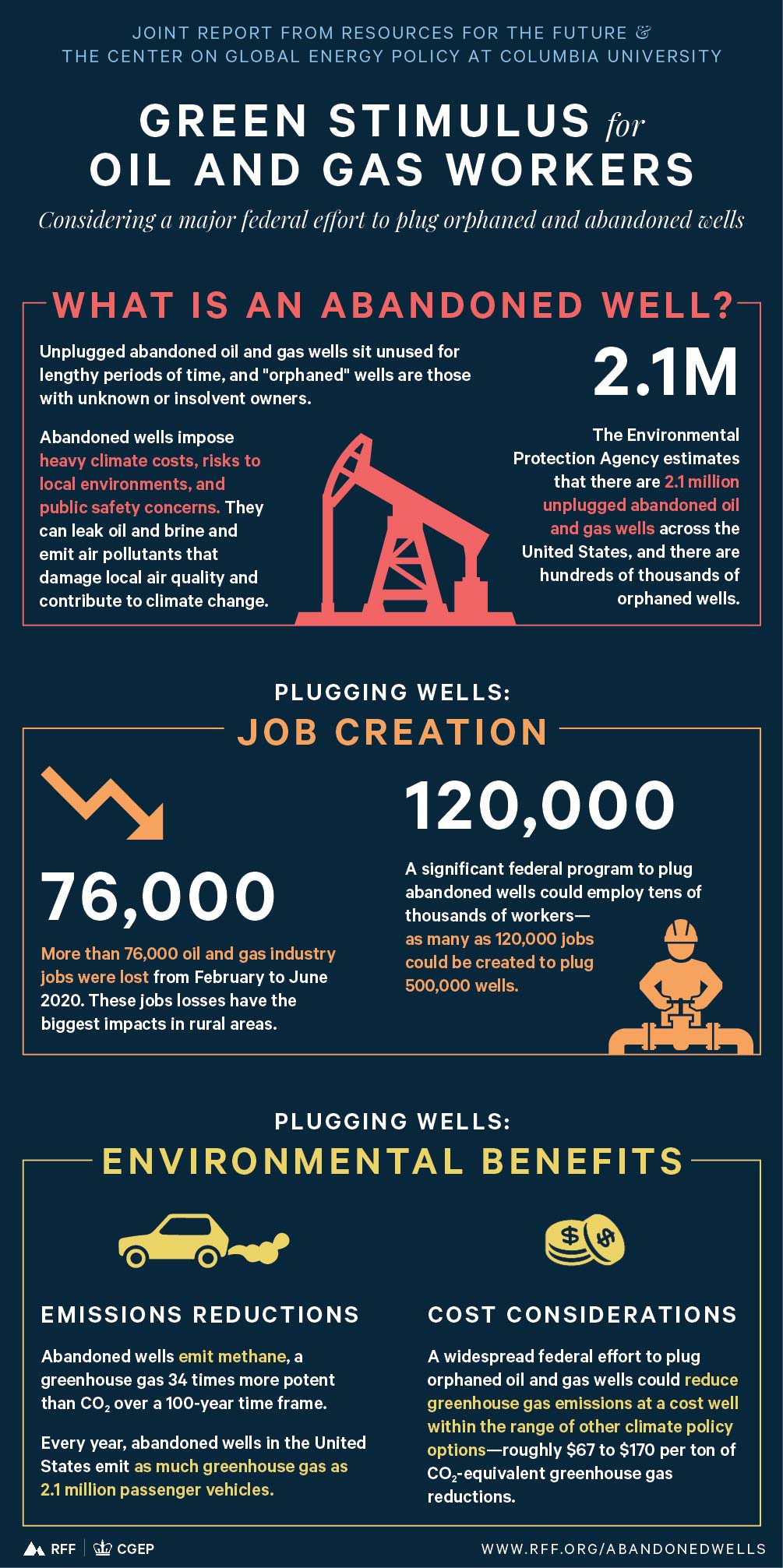Green Stimulus for Oil and Gas Workers: Considering a Major Federal Effort to Plug Orphaned and Abandoned Wells
This paper, a joint effort between Resources for the Future and the Center on Global Energy Policy at Columbia University, examines the potential to boost US employment in the oil and gas workforce while also reducing pollution through a federal program to plug orphaned and abandoned oil and gas wells.
Infographic: Report at a Glance

Executive Summary
The global economic damages wrought by COVID-19 have dramatically magnified the suffering caused by the deadly virus. US lawmakers have already approved $3 trillion in aid to help offset the economic damage, and additional measures are under consideration. At the same time, the need to invest trillions in economic recovery has prompted calls to “build back better” by making the recovery a greener, less carbon-intensive one.
This paper, a joint effort between Resources for the Future and the Center on Global Energy Policy at Columbia University, examines the potential to boost US employment in the oil and gas workforce while also reducing pollution through a federal program to plug orphaned and abandoned oil and gas wells. These wells can leak methane and other pollutants that contribute to climate change, poor air quality, and other health and environmental risks. This research included interviews with key regulatory and industry officials to present the most up-to-date information on this rapidly evolving issue.
While states and the federal government fund well plugging activities through bonding requirements, industry fees, and other sources, these funds have not historically been adequate to reduce the inventory of orphan unplugged wells. Many of these sites date back to the 19th and early 20th centuries, when regulations including bonding requirements were weak or, in many cases, nonexistent. Estimates for the total number of orphaned and abandoned wells range from several hundred thousand to 3 million, depending on the definition of such wells needing attention. At the same time the oil and gas industry, which has seen employment drop to levels not seen since 2006, appears able to scale up to carry out this work. Labor and equipment are readily available due to the low oil price environment created by the collapse in demand from the coronavirus.
The paper finds:
- A significant federal program to plug orphaned wells could create tens of thousands of jobs, potentially as many as 120,000 if 500,000 wells were plugged. Addressing 500,000 wells would require state, tribal, and federal agencies to identify and prioritize hundreds of thousands of additional wells, most of which are unaccounted for in current inventories of orphaned wells. These inventories indicate that the largest number of orphaned wells are in Pennsylvania.
- A widespread federal effort to plug orphaned and abandoned oil and gas wells would reduce local air pollution, safety risks, and greenhouse gas emissions at a cost of roughly $67 to $170 per ton of CO2-equivalent, well within the range of other policy options.
- A significant pool of labor from the oil and gas industry could be deployed toward and benefit from such a program. More than 76,000 direct industry jobs were lost from February to June of 2020, a number that is likely to rise in the months to come. The job losses have been especially acute in rural regions where domestic oil and gas production occurs and where economies are closely tied to industry fortunes, such as the Permian Basin in West Texas and New Mexico, the Marcellus in Pennsylvania and Ohio, the Bakken in North Dakota, and parts of California, Colorado, Louisiana, Oklahoma, and other states. In these regions, this downturn not only affects workers but also funding for schools, infrastructure, public safety, and more, as a prior collaboration between RFF and CGEP found.
- The costs of plugging and restoring well sites vary widely, and the total outlay of a well plugging program to address the known inventory of 56,600 orphaned wells could plausibly range from $1.4 billion to $2.7 billion. Expanding the program to identify and plug 500,000 wells could plausibly cost between $12 and $24 billion. States have different technical requirements for plugging wells and restoring surface locations, and some wells pose greater risks to groundwater, are harder to access, or are deeper than average. All these factors affect plugging and restoration costs.
- One potential challenge of a very large program (i.e., addressing hundreds of thousands of wells) is that state regulatory offices would likely need to scale up administrative capacity to oversee such programs.
- While states and the federal government require oil and gas companies to post bonds or other forms of financial assurance to pay for well plugging in case firms go bankrupt before plugging wells, these bonds often do not cover the full costs. Federal funding could exacerbate this problem if states and companies see it as alleviating their responsibility to plan for future remediation costs adequately. To avoid this, a federal program could prioritize plugging wells abandoned decades ago that were not subject to modern regulatory frameworks.






